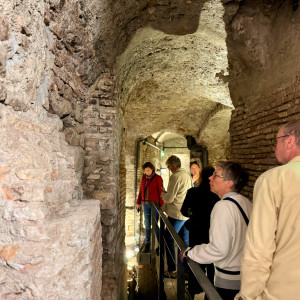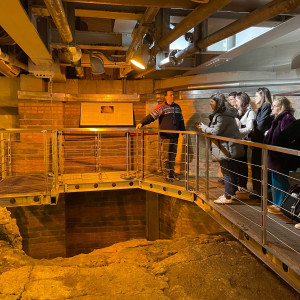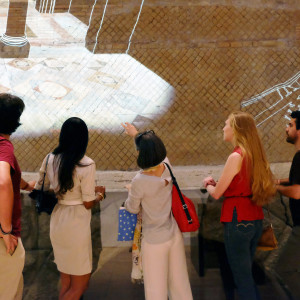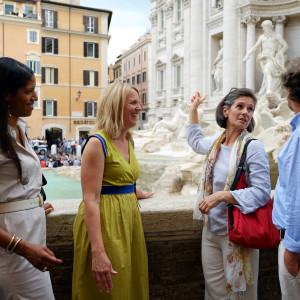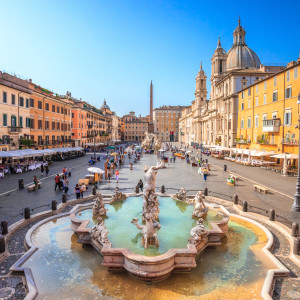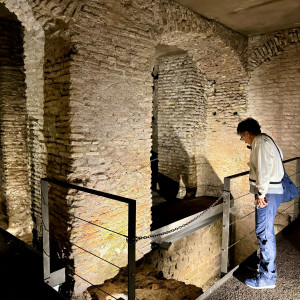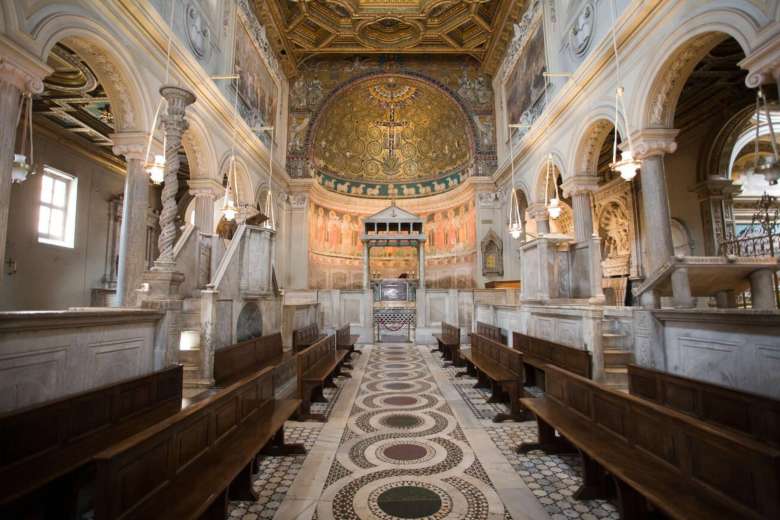Tour Details
Duration
3 hours
Product Type
Tour
Venues
- Vicus Caprarius
- Rinascente Tritone
- Stadium of Domitian
Select a date
Tour Description
Ever wondered what the streets of Rome looked like in the past? How much has changed over the centuries? Rome still holds countless traces of its ancient face: some hidden in plain sight, others buried beneath the modern city.
With the guidance of an experienced archaeologist or historian who knows where to look and what to look for, you can uncover these hidden remnants of the past. Explore ancient Roman apartments beneath a modern cinema and discover aqueducts tucked away under luxury shops. The Eternal City's history is made of layers, and this exclusive underground Rome tour unveils all its secrets, granting you private access to a hidden site reserved solely for you and your group.
Experts
You will begin near the Trevi Fountain at Vicus Caprarius, an archaeological gem hidden beneath a modern cinema. Here, you'll explore the remains of ancient Roman apartments, gaining insight into daily life in the past, right beneath today’s bustling city.
Next, you'll visit Rinascente Tritone, a stylish department store with a hidden secret: its basement houses the Aqua Virgo aqueduct, an engineering marvel dating back to 19 BC.
As you stroll through Rome’s vibrant streets, you’ll make your way to Piazza Navona. Unbeknownst to many, even locals, this lively square sits atop the Stadium of Domitian, a vast arena that once hosted thrilling athletic contests.
You will enjoy exclusive access to a private section of the Domitian Stadium at the École Française, right in the heart of Piazza Navona. Your guide will lead you beneath the bustling square for a truly exclusive experience reserved solely for you and your group. You'll have the rare opportunity to explore this remarkably well-preserved site at your own pace, pausing to reflect, ask questions, and fully absorb the atmosphere of this evocative underground space.
This intimate Rome underground tour through the city's layered history, guided by an experienced archeologist, offers a rare glimpse into the ancient world that lies quietly beneath the modern city.
- You’re intrigued by the contrast between modern Rome above ground and the ancient city hidden beneath, and want to explore how these two worlds coexist.
- You want a historian or archaeologist as your guide, bringing Rome’s past to life with expert knowledge and fascinating stories.
- You’re looking for an exclusive experience, gaining special access to hidden sites that most visitors never even realize exist
- Vicus Caprarius – excavated underground space showing ancient Roman apartments situated near the Trevi Fountain.
- Rinascente Tritone – modern department store housing the ancient Aqua Virgo aqueduct in its basement.
- Stadium of Domitian – ancient stadium located beneath Piazza Navona, including exclusive access to the restricted École Française site.
Tickets
- Includes tickets to Vicus Caprarius and the Stadium of Domitian.
- Upon receiving your order, our team will secure a guide. Once the venue tickets are released, we will purchase them. Our team will be in touch with alternative options if we cannot secure tickets for the date and time you requested.
Resources
- Check out our upcoming online lectures which transport you back to Ancient Rome, accompanied by a leading Context Expert.
- Check out Cities of the Underworld on the History Channel; many of the guides who lead this walk were featured on this program.
Wheelchair accessibility
- This tour may not be accessible for clients with limited mobility as it includes a lot of stairs and uneven grounds. Vicus Caprarius has only limited wheelchair-accessibility and Stadium of Domitian is not currently accessible as there are no ramps or elevators at the site and the terrain is uneven and difficult to navigate. Please inform us in case of mobility issues.
Service Dogs
- Service dogs are allowed if you have a medical certificate proving the need.
- For more information about Context Tours, please visit our FAQs.
Is this walk suitable for claustrophobic clients?
You do spend much of the tour underground, although you won't visit any site that is particularly narrow or small.
What makes the École Française site on Piazza Navona special?
You’ll have exclusive access to this private section of the Stadium of Domitian. Unlike other parts of the stadium, this area is reserved solely for your group, offering an intimate look at the well-preserved ruins and their fascinating history.
You do spend much of the tour underground, although you won't visit any site that is particularly narrow or small.
What makes the École Française site on Piazza Navona special?
You’ll have exclusive access to this private section of the Stadium of Domitian. Unlike other parts of the stadium, this area is reserved solely for your group, offering an intimate look at the well-preserved ruins and their fascinating history.
Where does the tour start?
The exact itinerary may vary based on reservation times and site availability, your tour may start at Vicus Caprarius or the Stadium of Domitian. Your confirmation email will include all the details and information.
The exact itinerary may vary based on reservation times and site availability, your tour may start at Vicus Caprarius or the Stadium of Domitian. Your confirmation email will include all the details and information.
Book worry-free—review our flexible cancellation policy here.
–
497 Reviews
Reviews can only be left by Context customers after they have completed a tour. For more information about our reviews, please see our FAQ.
We've had excellent experiences with Context in the past and had just taken a fantastic Context tour in Barcelona four days earlier; unfortunately, I'm sorry to say that the Underground Rome tour disappointed on several levels. First, the visited sites just didn't excite the imagination. We've been to the Mithraeum at S. Clemente before and expected to see something equally stunning here. But the stops here (S. Lorenzo, the cinema museum, Crypta Balbi) just didn't have that same "wow" factor. Perhaps this was a function of the spaces themselves (there's not much there in terms of dazzling mosaics or frescoes or mysterious altars). Or perhaps it's reflective of the other problem: that Erik needs to improve his guide skills.
For our untrained eyes, ruins are not easy to decipher at first glance. Past Context guides have brought along visual aides, handouts, illustrations, and other tools to help us picture the spaces as they were used, bring the spaces to life, and give context (a-ha!) to what we were seeing. Erik had no additional materials to offer, and he tended to march us into a space, talk about what interested him, and blow right past maps and descriptions at the sites (particularly at the cinema museum and Crypta Balbi) that explained the layout and functions of the spaces around us. We frequently had to hang back and steal time to read the wall cards and maps, which we found much more helpful and intriguing than anything we'd been told. Meanwhile, Erik sometimes seemed in a hurry to get back above ground. He's obviously knowledgeable, but he doesn't (at least on our visit) convey any excitement about the spaces. Past Context guides have projected an enthusiasm that made this seem like a calling for them; with Erik, we felt like he was marking time at a job. (Sorry, I know that's harsh, but it's how disengaged we felt on the tour.)
That brings us to our other concern/complaint: we spent more time traipsing around above ground than we did in the underground sites we thought we'd come to see. Much of our walking took us to utterly common destinations: Piazza Navona, the Trevi Fountain, the Pantheon -- seriously? Anyone taking an Underground Tour of Rome is obviously looking for something off (under?) the beaten path -- NOT the Trevi Fountain! I know Erik went there because he was trying to use Roman water supply as connective tissue for his tour, but find a more surprising and unexpected example for us. Take us somewhere that every single tourist hasn't visited in their first three hours in Rome.
Finally, Erik needs to pay more attention to and be more engaged with his guests. When he'd go marching off through the streets, threading his way through scooters and parked cars and moving traffic, he'd never look back to see if people were managing to follow okay. We're young and pretty agile, but sometimes we got cut off by traffic or fell behind for one reason or another; several times we had to shout ahead to ask him to slow down or wait. We'd also have to yell for him to double-back and answer a question about something we'd seen; that kind of discovery should be part of the fun of a walk like this, but those opportunities were few.
Thanks for taking the time to read all this. Hope it helps. (We still love Context.)
Thomas
Reviewed on:
Oct 25, 2013
Philip was excellent. So much information and ability to get us to see how the people of the past lived.
Kym
Reviewed on:
Oct 1, 2013
The initial meet up of the group was a bit confusing. We ended up asking various people in the square if they were with or waiting for the tour. Eventually we all came together. It would have been helpful if Philip had shown up a few minutes early with some indication that he was with Context.
Joseph
Reviewed on:
Sep 17, 2013
